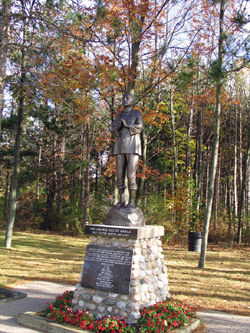Pilgrimage
For pilgrims in Canada, Ontario's Martyrs' Shrine offers a stop on their spiritual journey
By Michele Peterson
March 2005
Return to Table of Contents
Print Article
Each August, hundreds of pilgrims weave their way down country roads and across farmers' fields to Ontario's Martyrs' Shrine. Averaging 25 kilometres a day, pilgrims keep to the back roads to stay close to nature.
"By being totally dependent on the weather, we are in touch with nature and open to God's will," says John Zurakowski, leader of the six-day walking pilgrimage (inset) that culminates on August 15, the Feast of the Assumption. Akin to pilgrims of medieval times, they sleep in churches or tents and rely upon the generosity of local churches, residents and community groups for meals.
"The hospitality of others builds community," says John, consultant at the Toronto Archdiocese's Catholic Office of Religious Education.

The shrine to St. Lorenzo Ruiz, the first canonized Filipino martyr. In 2005, Martyrs' Shrine celebrates the 75th anniversary of the canonization of the Canadian martyrs and the 25th anniversary of the beatification of Blessed Kateri Tekakwitha, patroness of ecology. Martyrs' Shrine, Midland, Ontario. www.martyrs-shrine.com.
Most pilgrim participants are Catholic, with 75 percent under the age of 25. However, people from other Christian denominations and a few from other faith traditions have taken part.
"Pilgrimages are not exclusive of the Catholic tradition," says John. "They are an experience of emptying of self and letting God fill us. Our goal is to make pilgrimage a great spiritual journey for all people."
Martyrs' Shrine is one of Canada's four national shrines and the only national shrine outside of Quebec. It was built to honour the memory of eight martyrs-Jesuit Fathers, Brothers and lay volunteers who were missionaries among the Huron-Ouendats between 1625 and 1650. However, it has become a monument to martyrs around the world.
"Although we are a Roman Catholic shrine, we are open to all denominations and faiths," says Steve Parrotte, assistant director. "Post-World War II, we were approached by communities who came to pray at the church but wanted to create a lasting memorial to their own martyrs."
Today, the Martyrs' Shrine has shrines and monuments for a dozen different countries, including Belarus, Ireland, Portugal and the Philippines. However, new Canadians from every nation come to the Shrine to make pilgrimages of faith, or to remember martyrs such as Archbishop Romero of El Salvador and those lost to famine and war.
The landscaped grounds also contain the Stations of the Cross, walking trails for contemplation and an observation platform with a panoramic view across the southern shores of Georgian Bay where voyageur and Native canoes once navigated their way to wilderness settlements.
"This site has always been linked historically to Native traditions and is a very holy place," says Jane Andrews, group facilitator of the First Nations pilgrimage (inset) that has been taking place for 22 years.
"We welcome all faiths," says Andrews of their group of about 100 pilgrims led by the Kateri Prayer and Music Ministry. Following a candlelight ceremony, they visit Native parishes and sacred sites in the area. One site is St. Ignace where French Jesuit missionary St. Jean de Br.beuf was captured by the Iroquois during a battle and burned at the stake.
Whether a pilgrim comes to the Shrine alone or as part of a group, all are welcome to enjoy the peace and solitude of the grounds. For pilgrims, it may be an act of devotion or part of a quest for blessings or miracles. For others, it is simply a time for reflection. But for all, it is evidence that hope and faith connects and transforms us.
"Pilgrimages are something we all do together. We walk as one body, not as individuals, and the experience changes us," says Zurakowski.
Michele Peterson is a freelance writer living in Toronto.
Return to Table of Contents
Print Article